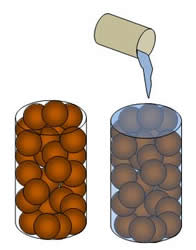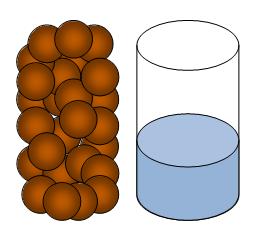After rain or irrigation, the pores in soil fill up with water. Soil moisture is two things, Soil Moisture Tension and Soil Moisture Content

Imagine you have a container of soil. Add water to it until it is full.

Now imagine you can take all the pieces of soil out, leaving just the water. This is the maximum amount of water that this soil can ever hold, this is a super saturated or waterlogged sample of soil.

Waterlogged soil is not good for plant growth as there is no air or oxygen in the pore spaces for the plant roots to extract and use. Roots will rapidly die in waterlogged soils.
Thankfully, gravity causes excess water to slowly drain away through the profile and end up in the water table. As the water drains, air (including oxygen) is pulled into the pore spaces, creating a good environment for roots.
Not all of the water will drain away, a large amount of it will stay in the soil:
- In the pore spaces, and
- As a thin coating on the outside of soil particles
After the excess water has drained away, the soil is said to be at field capacity. This is usually 2-3 days after the wetting event.
The water in the pores is easy for the plant roots to get to and use. The water that coats the soil particles may be tightly bound and the plant roots may not be able to extract it. So once the pore water is used up, even though the soil is still wet, plants may not be able to access the water and will start to wilt. The amount of water the plant can successfully extract from the soil is called the PLANT AVAILABLE WATER.
So how do you go about working out how much moisture is in your soil and how much the plant can actually use?
There are two ways to go about measuring soil moisture:
- Soil Moisture Content - the amount of water in the soil (usually described as a percentage)
- Soil Moisture Tension - how hard the plant root has to work to extract water from the soil